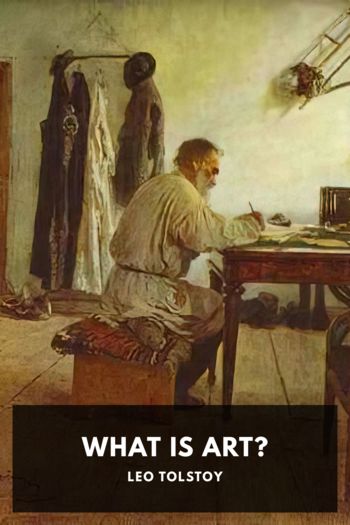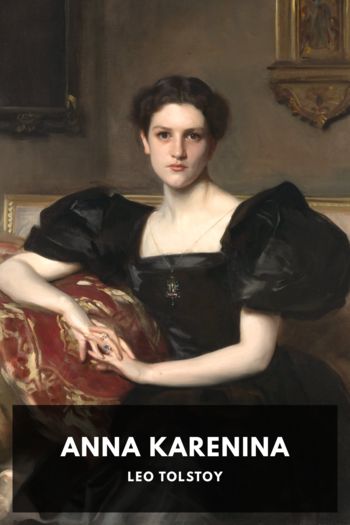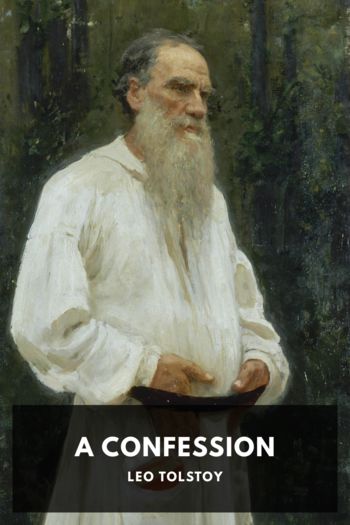What Is Art? by Leo Tolstoy (english readers .txt) 📕

- Author: Leo Tolstoy
Book online «What Is Art? by Leo Tolstoy (english readers .txt) 📕». Author Leo Tolstoy
And only then will art, which is always dependent on science, be what it might and should be, an organ coequally important with science for the life and progress of mankind.
Art is not a pleasure, a solace, or an amusement; art is a great matter. Art is an organ of human life, transmitting man’s reasonable perception into feeling. In our age the common religious perception of men is the consciousness of the brotherhood of man—we know that the well-being of man lies in union with his fellow-men. True science should indicate the various methods of applying this consciousness to life. Art should transform this perception into feeling.
The task of art is enormous. Through the influence of real art, aided by science guided by religion, that peaceful cooperation of man which is now obtained by external means—by our law-courts, police, charitable institutions, factory inspection, etc.—should be obtained by man’s free and joyous activity. Art should cause violence to be set aside.
And it is only art that can accomplish this.
All that now, independently of the fear of violence and punishment, makes the social life of man possible (and already now this is an enormous part of the order of our lives)—all this has been brought about by art. If by art it has been inculcated how people should treat religious objects, their parents, their children, their wives, their relations, strangers, foreigners; how to conduct themselves to their elders, their superiors, to those who suffer, to their enemies, and to animals; and if this has been obeyed through generations by millions of people, not only unenforced by any violence, but so that the force of such customs can be shaken in no way but by means of art: then, by the same art, other customs, more in accord with the religious perception of our time, may be evoked. If art has been able to convey the sentiment of reverence for images, for the eucharist, and for the king’s person; of shame at betraying a comrade, devotion to a flag, the necessity of revenge for an insult, the need to sacrifice one’s labour for the erection and adornment of churches, the duty of defending one’s honour or the glory of one’s native land—then that same art can also evoke reverence for the dignity of every man and for the life of every animal; can make men ashamed of luxury, of violence, of revenge, or of using for their pleasure that of which others are in need; can compel people freely, gladly, and without noticing it, to sacrifice themselves in the service of man.
The task for art to accomplish is to make that feeling of brotherhood and love of one’s neighbour, now attained only by the best members of the society, the customary feeling and the instinct of all men. By evoking, under imaginary conditions, the feeling of brotherhood and love, religious art will train men to experience those same feelings under similar circumstances in actual life; it will lay in the souls of men the rails along which the actions of those whom art thus educates will naturally pass. And universal art, by uniting the most different people in one common feeling, by destroying separation, will educate people to union, will show them, not by reason but by life itself, the joy of universal union reaching beyond the bounds set by life.
The destiny of art in our time is to transmit from the realm of reason to the realm of feeling the truth that well-being for men consists in being united together, and to set up, in place of the existing reign of force, that kingdom of God, i.e. of love, which we all recognise to be the highest aim of human life.
Possibly, in the future, science may reveal to art yet newer and higher ideals, which art may realise; but, in our time, the destiny of art is clear and definite. The task for Christian art is to establish brotherly union among men.
Appendices IThis is the first page of Mallarmé’s book Divagations:—
Le phénomène futur
Un ciel pâle, sur le monde qui finit de décrépitude, va peut-être partir avec les nuages: les lambeaux de la pourpre usée des couchants déteignent dans une rivière dormant à l’horizon submergé de rayons et d’eau. Les arbres s’ennuient, et, sous leur feuillage blanchi (de la poussière du temps plutôt que celle des chemins) monte la maison en toile de Montreur de choses Passées: maint réverbère attend le crépuscule et ravive les visages d’une malheureuse foule, vaincue par la maladie immortelle et le péché des siècles, d’hommes près de leurs chétives complices enceintes des fruits misérables avec lesquels périra la terre. Dans le silence inquiet de tous les yeux suppliant là-bas le soleil qui, sous l’eau, s’enfonce avec le désespoir d’un cri, voici le simple boniment: “Nulle enseigne ne vous régale du spectacle intérieur, car il n’est pas maintenant un peintre capable d’en donner une ombre triste. J’apporte, vivante (et préservée à travers les ans par la science souveraine) une Femme d’autrefois. Quelque folie, originelle et naïve, une extase d’or, je ne sais quoi! par elle nommé sa chevelure, se ploie avec la grâce des étoffes autour d’un visage qu’ éclaire la nudité sanglante de ses lèvres. A la place du vêtement vain, elle a un corps; et les yeux, semblables aux pierres rares! ne valent pas ce regard qui sort de sa chair heureuse: des seins levés comme s’ils étaient pleins d’un lait éternel, la pointe vers le





Comments (0)